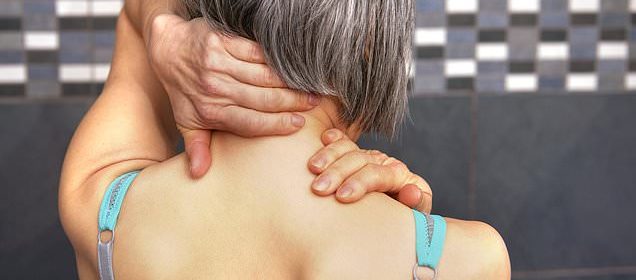Revealed: Two-fifths of adults are in pain by their mid-40s

Revealed: Two-fifths of adults are in pain by their mid-40s
- Chronic pain carries on for longer than 3 months despite drugs or treatment
- Such pain can affect all ages and all parts of the body, including the back
- Research is based on more than 12,000 Britons followed until the age of 62
More than two-fifths of people in Britain suffer from some form of chronic pain by the time they are in their mid-40s, a study suggests.
Chronic or persistent pain is pain that carries on for longer than three months despite medication or treatment.
It can affect all ages and all parts of the body – for example arthritis, back pain, headaches or all-over muscle pain.
Chronic or persistent pain is pain that carries on for longer than three months despite medication or treatment
Now, scientists have discovered people who suffer from persistent pain in their 40s are more likely to be unhappy, develop depression and be unemployed as they get older.
Their findings also suggest chronic pain at the age of 44 is linked to very severe pain at 51, and that sufferers will be more vulnerable to viruses such as Covid as they get older.
The research, published in the journal Plos One, is based on more than 12,000 people born in a single week in March 1958 in Britain who were followed until the age of 62.
Study co-author Professor Alex Bryson, of University College London’s Social Research Institute, said: ‘Chronic pain is a very serious problem affecting a large number of people.
‘Tracking a birth cohort across their life course, we find chronic pain is highly persistent and is associated with poor mental health outcomes later in life including depression, as well as leading to poorer general health and joblessness.
‘We hope that our research sheds light on this issue and its wide-ranging impacts, and that it is taken more seriously by policymakers.’
The study, funded by the Health Foundation, found that 41 per cent of people reported suffering chronic pain by the time they reached their mid-40s.
Results also showed those suffering with chronic pain at age 44 were more likely to be unhappy by age 50 and experience depression at age 55.
The survey indicated chronic pain to be associated with a higher likelihood of Covid-19 infection 20 years later, in 2021.
WHAT ARE THE MOST COMMON MYTHS ABOUT BACK PAIN?
You should always rest a bad back: Moderate exercise is essential to build and maintain strength and flexibility in the spine, improving posture and protecting you from any further pain. While total rest may seem like a good way to recover often continuing moderate physical activity will help in the long run. Your local chiropractor will be able to advise on what is right for you.
Back or neck pain is simply part of the ageing process: While ageing can have an impact on your back health, back or neck pain can occur at any age. Maintaining good health into later years and being aware of how to preserve one of our body’s most important assets, the back, is important in allowing us to maintain activity levels. The BCA has advice on how to protect your back at any age.
Back or neck pain is not common: Back and neck pain is very common, and statistics have shown that 80 per cent of people will experience back pain at some point in their lives.
The spine can be injured easily: The spine is actually one of the strongest parts of your body and is designed to be strong. Like any other part of your body though, taking good care of it is essential to allow it to do its job effectively for as long as possible.
A slipped disc means a disc has slipped out of your spine: The discs are circular pads of connective tissue – cartilage – in between each vertebra in your back. These discs have an inner gel-like substance and a tough outer case. They help maintain your back’s flexibility and wide range of movement. A slipped disc means that one of the discs of cartilage in the spine is damaged and possibly extruding, irritating or pressing on the nerves. It can also be known as a prolapsed or herniated disc.
Pain killers can cure back pain: Most back pain is ‘mechanical’ in nature so, even though painkillers can be helpful, some sort of mechanical, hands on treatment involving movement/exercise is more likely to help manage the problem and reduce recurrence.
Source: Read Full Article
